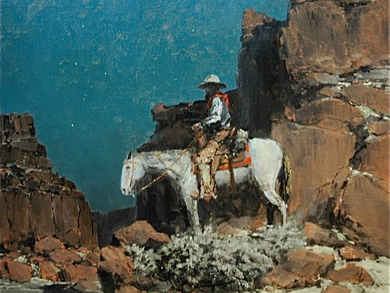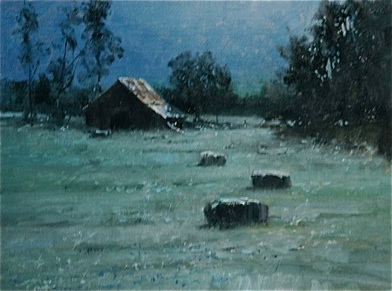About Nocturnes

Nocturnes are night paintings. This type of painting genre has always been challenging, because of the difficulty of painting “live”, and because the appearance of colors radically changes in the cool light of the moon.
I think moonlight adds an aura of mystique and spiritualism to paintings.
I have been studying the work of two masters of night time painting, the American western painters Frederick Remington and Frank Tenney Johnson. Both of these painters spent decades of their careers studying the effects of moonlight on objects and developed highly expressive manners for interpreting this light.
In the painting above, Canyon Nocturne, Portrait of Mr. Goodnight, I have painted in the style and influence of Frank Tenney Johnson. Notice the front lit moonlight pattern to the lighting. Though the moon provides an external light source, the figure seems almost as if illuminated from within. A great deal of detail is rendered, and I haven’t backed off of using some fairly warm colors.
It is the darkness, or night look of the sky that pretty much pulls off the nocturne effect.
In these next two paintings, I have painted more in the style of Frederick Remington. He usually preferred a colder more limited palette. Almost always relying on moonlight as the illumination source, his paintings have a more shadowy naturalistic feel about them. The objects look as if illuminated from without, not from within as does Frank Tenney Johnson.
Both paintings are exactly the same size and composition. I have used the same colors of paint in both pieces. I have painted them to illustrate two types of night light...back lighting and front lighting by the moon.
The painting above portrays a night scene when the moon, or light source, is in front of us, so everything appears backlit. Notice how objects in the distance seem so apparent...this is because of the back lighting, making them appear as if in silhouette. The backlit objects appear dark and flat, they don’t have much form. this is because moonlight is so weak that we don’t see a lot of reflected light in the shadow areas. Because of the back lighting we will see little sparkling “gems” of light reflecting off objects that are in front of us. There are more reflections on the ground. The sky is lighter because the part of the sky we are looking at has the moon in it, the glow lightening its appearance. Because of this lighter sky, we are unable to see many stars.
In the next painting shown above, I have painted the very same scene and composition only now as if the moon were behind us so the objects appear front lit. There are less noticeable sparkling highlights, as the reflections are now directed away from our eyes. Though objects are front lit, that are not as discernible because of the dimness of moonlight, we no longer see their shapes as dark silhouettes against a lighter sky. As things get further away from us it becomes harder to see them distinctly. Objects catching the moonlight do not shine because their reflections are directed away from our eyes if the moon is behind our backs. The ground will appear much flatter in color because we won’t see reflections as much for the reason I just stated, and because most of the shadows caused by the moon behind us means the cast shadows of objects are on the other side of the object, the side not facing us. The sky will appear darker
because the moon is behind us, illuminating that part of the sky. Therefore we will see stars much more easily because of the dark sky in front of our eyes.
Here are a few helpful tips for aspiring painters wishing to try their hand at night scenes:
Control your night colors with Paynes Grey or Lamp Black. Using compliments to bring down the chroma of paint does not work well for nocturnes, the color chroma remains too high key.
Determine what and where your light source is.
Be careful with values. There is a lot more nuance to the values than you first imagine.
The sky is rarely the darkest value in a good nocturne painting.
Make your shadows opague...there is little reflected light.
Go outside and OBSERVE the nightlight. I don’t think it works well to try and paint at night with a head light...the artificial light destroys your perception of the colors you are looking at and how you see the colors on your canvas. Instead go outside and be an OBSERVER, write notes to yourself about what you are observing; these notes can be very valuable to your painting perceptions.

Canyon Nocturne, Portrait of Mr. Goodnight
16 x 20, oil on linen panel
private collection


Hay Bales Nocturne, #1
9 x 12, oil on linen panel
back lighting
private collection
Hay Bales Nocturne, #2
9 x 12, oil on linen panel
front lighting
private collection
